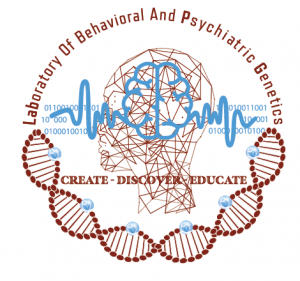Dr. Chunyu Liu – Searching for the Genetic Roots of Psychiatric Disorders
Decades of research indicate that mental health conditions and psychiatric disorders have a strong genetic basis. Expanding our understanding of mental health by encompassing a more systemic approach may help us improve both diagnosis and treatment. Dr. Chunyu Liu and his team from SUNY Upstate Medical University are using big data to discover the genetic and molecular changes in the brain that occur with different psychiatric disorders. His studies are helping us understand the diversity of human behaviour and develop new methods to treat mental health conditions.
Approaching the Complicated Mind with a Vision of Systems
Psychiatric disorders are as elusive to characterise as they are difficult to treat. As we should expect from conditions arising in the brain – the most complex organ of the body – the aetiology of mental health disorders remains poorly understood despite significant attempts to identify the root causes. The consensus is that a combination of environmental and genetic factors increases the likelihood of mental illness, but pinpointing universal causative mechanisms has remained difficult due to the unique combination of factors pertaining to each and every individual.
Research into molecular genetics has advanced significantly in the last ten years and the rapid evolution of available technologies has been a major driving force behind this. Such technologies include genome-wide association studies (GWAS), whole-genome and whole-exome sequencing techniques, and all forms of -omics which aim to associate a specific gene (or gene variant) with a given condition.
Dr. Chunyu Liu and his team from Upstate Medical University are using these tools to explore the genetic underpinnings of human behaviour and how gene variants can be linked to mental illnesses including schizophrenia, bipolar disorder, autism spectrum disorder, attention deficit hyperactivity disorder, and others.
‘I am interested in learning what determines human behaviour, including that of abnormality and so-called “mental illness” with the goal to develop effective methods for prognosis, diagnosis and treatment to reduce the associated suffering’ explains Dr. Liu. His work is revolutionising what we know about the genetic architecture of major psychiatric disorders.
Dr. Liu wants to make it clear that brain research should focus on biological networks and systems, rather than single genes or factors. Known as systems biology, this approach takes into account all the components which coexist in our bodies and interact with each other. Taking a more holistic view can help link together the environmental and genetic factors and their interactions that may increase the risk of psychiatric problems.

Searching for the Genetic Codes of Psychiatric Disorders
Searching for genes associated with a condition was once a time-consuming and expensive process. But now, whole genomes can be characterised and uploaded into a database available for researchers all over the world to access and explore.
As noted earlier, GWAS can identify specific variations of a gene which might be associated with a certain condition. These variants, known as single-nucleotide polymorphisms (SNPs), are a version of a gene which may still perform its function but has a single nucleotide difference. This tiny change can alter gene function or expression levels, and subsequently, an individual’s predisposition to a condition. Analysing SNPs in the human population, comparing people with different characteristics, can help us understand why some people are more at risk of certain conditions than others.
To perform a GWAS, researchers take DNA samples from participants with and without a condition – schizophrenia, for example – and use genotyping technology to identify SNPs. The groups of people with contrasting conditions are then compared to see if any of the SNPs are more frequently observed with a condition and thus, could potentially be used as a diagnostic tool or a target for treatment.
Dr. Liu emphasises that SNPs account for only a small percentage of the genetic risk for these highly complex disorders, representing only the very tip of the iceberg. Indeed, GWAS can identify thousands of potential genes involved in a single psychiatric condition. These genes connect to the other thousands of genes with even weaker effects that are more difficult to detect. Unravelling the different roles of ‘core’ genes from the ‘peripheral’ genes, and the connections among them, is essential to piece together the puzzle and identify key genes and biological pathways involved.
GWAS research has borne many discoveries in the field of psychiatry, but improvements to data analysis methods and reproducibility, and integration with other types of data are necessary to fully legitimise the field. Solutions may come from multi-omics integration, combined big data, and deploying machine learning data analysis.
‘We do not have a simple, crystal clear, answer yet. But we are getting there.’

Reading the Scripts Beyond Genetic Codes
When studying the genetic associations of a condition, it is important to remember that only 1% of the human genome is expressed into proteins. The transcriptome, on the other hand, encompasses all the genes which are transcribed from DNA to RNA. A subset of RNA, and more specifically, messenger RNA (mRNA), is the intermediary between DNA and protein. mRNA can be used as a quantitative measure to find out where certain genes are expressed. For example, if a gene’s RNA is expressed highly in the brain but not elsewhere, or if the gene expressed highly in specific developmental or ageing stages, we can deduce that this gene and its protein plays a role in brain function. Moreover, this quantitative measurement of gene expression can be used to study how gene expression is regulated.
To complicate things, one gene can have many different splicing isoforms, by utilising alternative pieces of its components (so-called exons). Different isoforms can have different functions. This introduces another level of diversity into the genome. The number of different proteins produced by the genome is much larger than the number of protein-coding genes. Recent studies suggest that changes in splicing isoforms might contribute to disease risk while the overall expression level of a gene may remain unchanged. Studying this type of variation alongside other genetic differences like SNPs can reveal more and more about the changes that occur at a molecular level in psychiatric disorders.
Genes and their encoded proteins do not represent the entirety of genetic influence. A level up from this is that of epigenetic factors which alter the way genes can be expressed. These include DNA methylation, histone modifications, and non-coding RNA. Epigenetic changes are heritable and can alter the location, intensity, and timing of a gene’s expression. To date, epigenetic factors have been important sources of biomarkers of disease diagnosis and treatment.
Using genetic and epigenetic technologies, Dr. Liu demonstrated that genetic differences can affect individual differences in DNA methylation. He pioneered efforts mapping genetic regulators of gene expression in the human brain, and in interpreting the results of genetic studies. Through collaboration with other researchers, concerted molecular changes in patients’ brains have been uncovered.
Critically, the researchers found that different disorders have shared disordered changes. These changes are concentrated in specific brain cell types (neurons, microglia, and astrocytes), biological pathways like synaptic functions, mitochondria, and the immune response. Some of these changes are genetically determined, like those related to the neuronal functions of oligodendrocytes and astrocytes. The others might be affected by environmental factors like the immune response, mitochondria, and the blood-brain barrier.

Mental health psychology and psychological disorders mecical concept with 3D illustration elements.
Forging New Paths
Dr. Liu is endlessly bringing new tools, datasets, and theoretical frameworks to his research to deepen the mechanistic understanding of disease risk, and to ensure the reliability of research results. Examples include the study of cellular models of risk genes, sex and racial background of diseases. These are not only important for understanding disease mechanisms but also critical for addressing social (in)justice related to health.
Dr. Liu and his team are joining with other research laboratories using cellular models to study the functions of hundreds of risk genes identified by large genetic studies They have now confirmed that some risk genes can regulate expression of other genes, influence cell proliferation and differentiation in the brain and the electrophysiology of neurons. This type of research will be critical for revealing the underlying mechanism of psychiatric disorders.
Recent work by Dr. Liu and his team has revealed the complicated nature of sex-biased risk in psychiatric disorders, such as an up to three-fold increase in the likelihood for females to develop major depression compared to males. His research points to the role of epigenetic DNA methylation and the regulatory networks which control this, where sex differences exist in the pattern of DNA methylation and perhaps alter the subsequent gene transcription and function. This was found to be particularly prominent in genes associated with psychiatric disorders and neuronal signalling pathways, and may pave the way for studies that may lead us to refined treatment for patients of different sexes.
To date, the majority of current studies have been conducted on European descents. Dr. Liu is interested in addressing this diversity issue while serving as the first chair of the Global Diversity Committee of the International Society of Psychiatric Genetics for four years. Currently, his team is actively studying the gene expression regulation in brains of diverse population backgrounds. This is a critical gap that needs to be filled to make genetic research beneficial to all human beings without disparity.
We can clearly see how interesting new lines of research are bringing together concepts from multiple fields of study. As techniques and technologies improve, we can expect to see even further advancements in our understanding of genetics in relation to psychiatry, and compelling leads from GWAS have even suggested links between predisposition to psychiatric disorders and physical traits. Such research is providing a transformative understanding of the pathology of psychiatric disorders.
In this regard, Dr. Liu believes in big data. He believes that big data integrating factors including biology, psychology and the social environment will offer a solution to understanding highly challenging psychiatric disorders. Despite the well-accepted dominant biopsychosocial model in clinical practice, there is still a lot to be done in basic research to integrate psychological and social factors with molecular genetics. Such molecular changes and genetic factors relating to psychological stress and treatment responses are examples of topics Dr. Liu’s team is now exploring.
Reproducibility of findings is the most important problem to be addressed in the research field but it may be achieved with big data and replication. Dr. Liu strongly emphasises the importance of integration and reproducibility. He explains, ‘We are getting closer and closer to the truth, to the heart of the problem. We are zooming in at unprecedented speed with the big data produced by us, by the collaborative research community through the world.’
By improving our understanding of how genes control molecular pathways disrupted in disease, we can better understand the underpinnings of human behaviour in health. Dr. Liu believes that as we gather more detailed information, we will be able to reshape the psychiatric diagnostic system and develop new treatments options to fit the individuality of each person. This will bring psychiatry into the world of precision medicine, where every patient can be treated with the optimal methods specific to that individual. ‘We do not have a simple, crystal clear, answer yet’ Dr. Liu explains, ‘But we are getting there.’
Reference
https://doi.org/10.33548/SCIENTIA662
Meet the researcher

Dr. Chunyu Liu
Institute for Human Performance
Upstate University
Syracuse
New York, NY
USA
Dr. Chunyu Liu graduated from Hunan Medical University, China, in 1998 with a PhD in Medical Genetics, before joining the faculty of the University of Chicago where he worked until 2011. In 2017, Dr. Liu began working at Upstate Medical University, Syracuse, New York, where he currently holds the posts of Professor of Psychiatry and Behavioural Sciences and Professor of Neuroscience and Psychology. Dr. Liu’s research focuses on identifying molecular mechanisms of psychiatric disorders using genetic and genomic approaches to characterise the changes that occur in mental health conditions. He is a member of the American College of Neuropsychopharmacology, the American Society of Human Genetics, and the International Society of Psychiatric Genetics.
CONTACT
E: liuch@upstate.edu
W: http://lbpg.upstate.edu/research.html
KEY COLLABORATORS
Elliot S. Gershon, University of Chicago
Kevin P. White, Tempus
Yue Wang, Virginia Polytechnic Institute and State University
Guoqiang Yu, Virginia Polytechnic Institute and State University
Junming Peng, St. Jude Children’s Hospital
Xusheng Wang, University of North Dakota
Bingshan Li, Vanderbilt University
Jeffrey Bishop, University of Minnesota
Stella Dracheva, Mount Sinai
Eric Gamazon, Vanderbilt University
Chao Chen, Central South University
Jingjing Zhao, Shaanxi Normal University
Dalila Pinto, Mount Sinai
Sidney Wang, The University of Texas
FUNDING
National Institutes of Health
National Alliance for Research on Schizophrenia & Depression
Brain Research Foundation
New York State Empire Innovation Program
Further Reading
X Yan, D Rujia, W Kangli, et al., Sex-differential DNA methylation and associated regulation networks in human brain implicated in the sex-biased risks of psychiatric disorders, Molecular Psychiatry, 2019, doi:10.1038/s41380-019-0416-2
N Yuan, Y Chen, Y Xia, et al., Inflammation-related biomarkers in major psychiatric disorders: a cross-disorder assessment of reproducibility and specificity in 43 meta-analyse, Translational Psychiatry, 2019, 9, 233.
C Chen, Q Meng, Y Xia, et al., POU3F2 is a regulator of a gene coexpression network in brain tissue from patients with neuropsychiatric disorders, Science Translational Medicine, 2018, 10(472), eaat8178.
MJ Gandel, P Zhang, E Hadjimichael, et al., Transcriptome-wide isoform-level dysregulation in ASD, schizophrenia, and bipolar disorder, Science, 2018, 362(6420), eaat8127.
MJ Gandal, JR Haney, NN Parikshak, et al., Shared molecular neuropathology across major psychiatric disorders parallels polygenic overlap, Science, 2018, 359(6376), 693–697.
Q Meng, K Wang, T Brunetti, et al., The DGCR5 long noncoding RNA may regulate expression of several schizophrenia-related genes, Science Translational Medicine, 2018, 10(472), eaat6912.
C Liu, QTL Mapping of Molecular Traits for Studies of Human Complex Diseases, Applied Computational Genomics: Springer Netherlands, 2012, 61–82.
LK Davis, ER Gamazon, E Kistner-Griffin, et al., Loci nominally associated with autism from genome-wide analysis show enrichment of brain expression quantitative trait loci but not lymphoblastoid cell line expression quantitative trait loci, Molecular Autism, 2012, 3(1), 3.

Want to republish our articles?
We encourage all formats of sharing and republishing of our articles. Whether you want to host on your website, publication or blog, we welcome this. Find out more
Creative Commons Licence
(CC BY 4.0)
This work is licensed under a Creative Commons Attribution 4.0 International License. 
What does this mean?
Share: You can copy and redistribute the material in any medium or format
Adapt: You can change, and build upon the material for any purpose, even commercially.
Credit: You must give appropriate credit, provide a link to the license, and indicate if changes were made.
More articles you may like
Calculating Steering Friction: Essential Engineering for Military Aircraft Safety
The safe operation of military training aircraft depends on precise engineering calculations that most of us never consider. Dr Bogdan Adrian Nicolin and Dr Ilie Nicolin from the National Institute for Aerospace Research in Romania have developed sophisticated methods to calculate the steering friction moment in military aircraft. This critical engineering parameter ensures that pilots can safely control aircraft during taxiing, take-off, and landing – making their work essential for both pilot training and flight safety.
Professor Robert B Heimann | Culinary Craftmanship: The Evolution of Pottery for Cooking
Cooking food is arguably one of the most important transitions in human evolution, and initiated hundreds of thousands of years of refinement in both technique and technology. Professor Emeritus Robert B Heimann of TU Bergakademie Freiberg, Germany, recently reviewed the evidence for early cooking vessels and tracks the evolution of their production, identifying important strategies of optimisation using various natural materials, firing methods, and designs to improve durability, functionality, and efficiency over time.
Dr Loren Babcock | Untangling the History of Jefferson’s Giant Ground Sloth
In the spring of 1796, workers mining saltpetre in a western Virginia cave unearthed several unusual bones. This would launch the scientific study of extinct animals in North America and connect one of America’s founding fathers to the early development of palaeontology. Some of these mysterious bones eventually made their way to future US President Thomas Jefferson at his Monticello estate. Dr Loren Babcock from The Ohio State University’s School of Earth Sciences has conducted an extensive review of the complex naming history of this iconic extinct animal. His research untangles over 200 years of inconsistent scientific terminology and establishes the definitive nomenclatural history of what would become known as Megalonyx jeffersonii.
Epigenetic Mysteries Unravelled: The Zinc-Finger Proteins
Exploring the complex mechanisms of cell development processes and DNA structure is critical to understanding how certain diseases, such as cancer, can arise. Professor Danny Reinberg and Dr Havva Ortabozkoyun from the University of Miami in Florida, USA, work to reveal the epigenetic mechanisms at play during cell division and development and, in turn, disease processes. Together, they are discovering new protein molecules involved in genome organisation, deepening our understanding of how cancers and other related conditions can develop.




